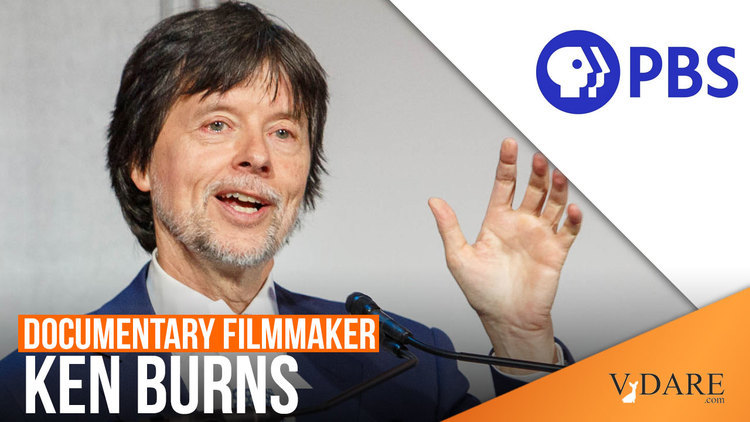
By Steve Sailer
09/19/2022
I wrote in 2011 about documentarian Ken Burns’ curiously black-heavy quasi-history of the National Park System, America’s Best Idea:
Still, adrift inside the vast hulk of Baseball was an excellent two-hour documentary on the one topic that truly engaged Burns: the Negro Leagues and the Jackie Robinson story.
As more Burns documentaries piled up, it became clear that what he cares most about is telling stories about African Americans. This was acidly pointed out in the famous parody, The Old Negro Space Program:
It was a different time, you understand. In 1957 or 1958, if you were black and you were an astronaut, you were outta work.
In 2007, Latino pressure groups successfully exploited Burns “notorious lack of interest in nonblacks” by raising a stink over the shortage of Hispanics in his WWII documentary The War. He ended up caving in and inserting an extra 28 minutes of Latino Lore, that, in the words of a New Yorker reviewer, felt “tacked-on.”
In a better world, Burns could devote himself solely to making documentaries about African American subjects. There is plenty of good material, and he’s the best at it. But, in this world, he can’t: he’s white. It would be like a white actor in 2008 or 2009 being the world’s best at playing Othello: he’d be outta work. It is a different time, you understand.
(Indeed, Burns is about as white as a white guy can get. His general affect is reminiscent of the liberal social worker in the pilot episode of King of the Hill whom Hank dubs “Twig Boy.”)
From The Guardian:
Interview
Ken Burns: ‘We’re in perhaps the most difficult crisis in the history of America’
David Smith in Washington
In a new docuseries, the film-maker looks back to the Holocaust and US apathy to make links toward where we are right now
@smithinamerica
Mon 19 Sep 2022 10.44 EDTKen Burns is driving in heavy traffic, trying to get from New York, where he was born, to New Hampshire, where he lives and works in bucolic splendour.
Burns, who was born in Brooklyn, lives in a small town in New Hampshire that is 96.0% non-Hispanic white.
He made the move in 1979, not to service a grand masterplan but out of financial desperation.
“I was making my first film and starving and rent was going up in New York City and I couldn’t afford it,” the documentarian recalls by phone.
Actually, rent was pretty low in Taxi Driver–esque New York in 1979, especially in Brooklyn (where he was born), which seems relevant considering Burns was then (or soon) working on his 1981 breakthrough documentary The Brooklyn Bridge.
But lots of people white-flighted out of 1970s New York City to very white northern New England. Jews, such as Bernie Sanders and Ben & Jerry, tended to go to Vermont. The WASPy Burns went to New Hampshire.
“I found the connection to nature incredibly important for this labour-intensive work that we do.”
But when Burns’s debut film, Brooklyn Bridge, was nominated for an Oscar, friends and colleagues assumed that he would move back to New York or try Los Angeles. He surprised them. “I made the biggest, the most important professional decision, which was to stay.
“I live in nature. I walk constantly and do a lot of letter writing and speechwriting and script writing and script fixing and editing in my head and that’s very helpful. And I happen to live in a particularly beautiful part of the country.”
Perhaps it is no accident that Burns settled in New Hampshire, a state that inspired Thornton Wilder’s Our Town, a quintessential play about the American experience. Something in the New England air has helped him produce epics on The Civil War, The War (about the second world war) and The Vietnam War; cultural studies of Baseball, Country Music, Jazz and The National Parks; profiles spanning The Roosevelts, Hemingway, Muhammad Ali and Benjamin Franklin.
Now comes The US and the Holocaust, a three-part PBS series directed and produced by Burns, Lynn Novick and Sarah Botstein and written by Geoffrey Ward. Over six hours, it examines America’s flawed response to the Nazis’ persecution and mass murder of Jews, asking what could have been done differently to halt the genocide. Voice actors include Liam Neeson, Matthew Rhys, Paul Giamatti, Meryl Streep, Werner Herzog, Joe Morton and Hope Davis.
It may be Burns’s most didactic film yet as it ends provocatively with images of Dylann Roof, who shot and killed nine African American congregants at a church in South Carolina; white supremacists marching with flaming torches in Charlottesville, Virginia, chanting “Jews will not replace us!”; the killing of 11 worshippers at a synagogue in Pittsburgh; and the storming of the US Capitol by a mob of Donald Trump supporters on 6 January 2021.
That Burns chooses to live in a Norman Rockwell-style time capsule village probably helped him get in sync culturally with 19th century Americans in his 1990 masterpiece, The Civil War.
On the other hand, these days, he wants his documentaries to be Relevant. But his comically complete detachment from the realities of life in 21st century American tends to undermine the actual relevance of his increasingly strident political opinions about a modern America troubled by massive immigration and growing black crime.
In his 96% Diversity Free white flight bubble, Ken doesn’t have to worry much about the consequences of his political grandstanding.
But other Americans aren’t that privileged.
This is a content archive of VDARE.com, which Letitia James forced off of the Internet using lawfare.